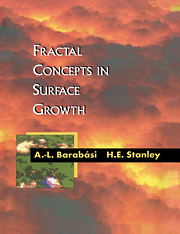Book contents
- Frontmatter
- Contents
- Preface
- Notation guide
- PART 1 Introduction
- PART 2 Nonequilibrium roughening
- PART 3 Interfaces in random media
- PART 4 Molecular beam epitaxy
- 12 Basic phenomena of MBE
- 13 Linear theory of MBE
- 14 Nonlinear theory for MBE
- 15 Discrete models for MBE
- 16 MBE experiments
- 17 Submonolayer deposition
- 18 The roughening transition
- 19 Nonlocal growth models
- 20 Diffusion bias
- PART 5 Noise
- PART 6 Advanced topics
- PART 7 Finale
- APPENDIX A Numerical recipes
- APPENDIX B Dynamic renormalization group
- APPENDIX C Hamiltonian description
- Bibliography
- Index
16 - MBE experiments
Published online by Cambridge University Press: 23 December 2009
- Frontmatter
- Contents
- Preface
- Notation guide
- PART 1 Introduction
- PART 2 Nonequilibrium roughening
- PART 3 Interfaces in random media
- PART 4 Molecular beam epitaxy
- 12 Basic phenomena of MBE
- 13 Linear theory of MBE
- 14 Nonlinear theory for MBE
- 15 Discrete models for MBE
- 16 MBE experiments
- 17 Submonolayer deposition
- 18 The roughening transition
- 19 Nonlocal growth models
- 20 Diffusion bias
- PART 5 Noise
- PART 6 Advanced topics
- PART 7 Finale
- APPENDIX A Numerical recipes
- APPENDIX B Dynamic renormalization group
- APPENDIX C Hamiltonian description
- Bibliography
- Index
Summary
As discussed in the previous chapters, we can distinguish the various growth processes based on the concept of universality. Interfaces that belong to the same universality class are described by the same scaling exponents, and they are also described by the same continuum equation.
The universality class is determined by the physical processes taking place at the surface. There are three basic microscopic processes that can play a major role in this respect: deposition, desorption, and surface diffusion. In addition to these, nonlocal effects such as shadowing may play a decisive role in shaping the interface morphology. While deposition must occur, the other microscopic processes may be irrelevant or even absent altogether. For example, in many systems desorption is negligible, while at low temperatures surface diffusion may be negligible.
A number of recent experiments support the existence of kinetic roughening in various deposition processes. It is possible to measure both the roughness exponent α characterizing the interface morphology, and the exponent β quantifying the dynamics of the roughening process. However, the emerging picture is far from complete, and there is no unambiguous support for the various universality classes.
There are a number of reasons for this situation. First, it is only recently that experimental groups have initiated systematic investigations of the various roughening processes. While the results are quite encouraging, more work is needed to obtain a coherent picture. Second, due to the complicated nature of the competing effects discussed in the previous chapters, the interpretation of the data is often not straightforward.
- Type
- Chapter
- Information
- Fractal Concepts in Surface Growth , pp. 166 - 174Publisher: Cambridge University PressPrint publication year: 1995



